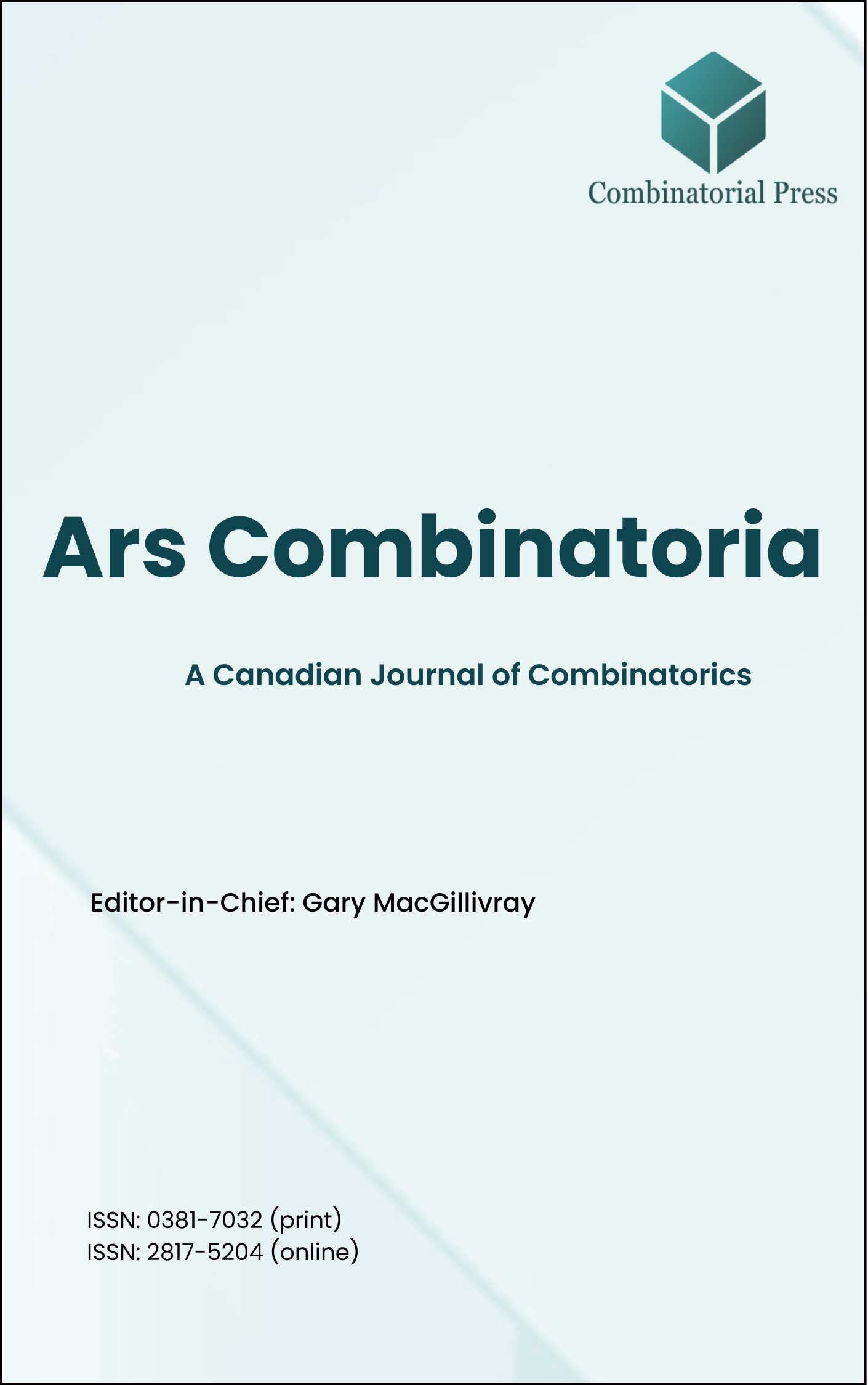
Ars Combinatoria
ISSN 0381-7032 (print), 2817-5204 (online)
Ars Combinatoria is the oldest Canadian Journal of Combinatorics, established in 1976. The journal is dedicated to advancing the field of combinatorial mathematics through the publication of high-quality research papers. From 2024 onward, it publishes four volumes per year in March, June, September and December. Ars Combinatoria has gained recognition and visibility in the academic community and is indexed in renowned databases such as MathSciNet, Zentralblatt, and Scopus. The Scope of the journal includes Graph theory, Design theory, Extremal combinatorics, Enumeration, Algebraic combinatorics, Combinatorial optimization, Ramsey theory, Automorphism groups, Coding theory, Finite geometries, Chemical graph theory but not limited.
Information Menu
- Research article
- https://doi.org/10.61091/ars-160-08
- Full Text
- Ars Combinatoria
- Volume 160
- Pages: 73-83
- Published: 30/09/2024
For a graph \( G \) and a subgraph \( H \) of a graph \( G \), an \( H \)-decomposition of the graph \( G \) is a partition of the edge set of \( G \) into subsets \( E_i \), \( 1 \leq i \leq k \), such that each \( E_i \) induces a graph isomorphic to \( H \). In this paper, it is proved that every simple connected unicyclic graph of order five decomposes the \( \lambda \)-fold complete equipartite graph whenever the necessary conditions are satisfied. This generalizes a result of Huang, *Utilitas Math.* 97 (2015), 109–117.
- Research article
- https://doi.org/10.61091/ars-160-07
- Full Text
- Ars Combinatoria
- Volume 160
- Pages: 59-71
- Published: 30/09/2024
We classify the geometric hyperplanes of the Segre geometries, that is, direct products of two projective spaces. In order to do so, we use the concept of a generalised duality. We apply the classification to Segre varieties and determine precisely which geometric hyperplanes are induced by hyperplanes of the ambient projective space. As a consequence we find that all geometric hyperplanes are induced by hyperplanes of the ambient projective space if, and only if, the underlying field has order \(2\) or \(3\).
- Research article
- https://doi.org/10.61091/ars-160-06
- Full Text
- Ars Combinatoria
- Volume 160
- Pages: 37-57
- Published: 30/09/2024
A modification of Merino-Mǐcka-Mütze’s solution to a combinatorial generation problem of Knuth is proposed in this survey. The resulting alternate form to such solution is compatible with a reinterpretation by the author of a proof of existence of Hamilton cycles in the middle-levels graphs. Such reinterpretation is given in terms of a dihedral quotient graph associated to each middle-levels graph. The vertices of such quotient graph represent Dyck words and their associated ordered trees. Those Dyck words are linearly ordered via a rooted tree that covers all their tight, or irreducible, forms, offering an universal reference point of view to express and integrate the periodic paths, or blocks, whose concatenation leads to Hamilton cycles resulting from the said solution.
- Research article
- https://doi.org/10.61091/ars-160-05
- Full Text
- Ars Combinatoria
- Volume 160
- Pages: 31-35
- Published: 30/09/2024
The hub cover pebbling number, \(h^{*}(G)\), of a graph $G$, is the least non-negative integer such that from all distributions of \(h^{*}(G)\) pebbles over the vertices of \(G\), it is possible to place at least one pebble each on every vertex of a set of vertices of a hub set for \(G\) using a sequence of pebbling move operations, each pebbling move operation removes two pebbles from a vertex and places one pebble on an adjacent vertex. Here we compute the hub cover pebbling number for wheel related graphs.
- Research article
- https://doi.org/10.61091/ars-160-04
- Full Text
- Ars Combinatoria
- Volume 160
- Pages: 21-29
- Published: 30/09/2024
An outer independent double Roman dominating function (OIDRDF) on a graph \( G \) is a function \( f : V(G) \to \{0, 1, 2, 3\} \) having the property that (i) if \( f(v) = 0 \), then the vertex \( v \) must have at least two neighbors assigned 2 under \( f \) or one neighbor \( w \) with \( f(w) = 3 \), and if \( f(v) = 1 \), then the vertex \( v \) must have at least one neighbor \( w \) with \( f(w) \ge 2 \) and (ii) the subgraph induced by the vertices assigned 0 under \( f \) is edgeless. The weight of an OIDRDF is the sum of its function values over all vertices, and the outer independent double Roman domination number \( \gamma_{oidR}(G) \) is the minimum weight of an OIDRDF on \( G \). The \( \gamma_{oidR} \)-stability (\( \gamma^-_{oidR} \)-stability, \( \gamma^+_{oidR} \)-stability) of \( G \), denoted by \( {\rm st}_{\gamma_{oidR}}(G) \) (\( {\rm st}^-_{\gamma_{oidR}}(G) \), \( {\rm st}^+_{\gamma_{oidR}}(G) \)), is defined as the minimum size of a set of vertices whose removal changes (decreases, increases) the outer independent double Roman domination number. In this paper, we determine the exact values on the \( \gamma_{oidR} \)-stability of some special classes of graphs, and present some bounds on \( {\rm st}_{\gamma_{oidR}}(G) \). In addition, for a tree \( T \) with maximum degree \( \Delta \), we show that \( {\rm st}_{\gamma_{oidR}}(T) = 1 \) and \( {\rm st}^-_{\gamma_{oidR}}(T) \le \Delta \), and characterize the trees that achieve the upper bound.
- Research article
- https://doi.org/10.61091/ars-60-03
- Full Text
- Ars Combinatoria
- Volume 160
- Pages: 13-19
- Published: 30/09/2024
We introduce a two-player game where the goal is to illuminate all edges of a graph. At each step the first player, called Illuminator, taps a vertex. The second player, called Adversary, reveals the edges incident with that vertex (consistent with the edges incident with the already tapped vertices). Illuminator tries to minimize the taps needed, and the value of the game is the number of taps needed with optimal play. We provide bounds on the value in trees and general graphs. In particular, we show that the value for the path on \( n \) vertices is \( \frac{2}{3} n + O(1) \), and there is a constant \( \varepsilon > 0 \) such that for every caterpillar on \( n \) vertices, the value is at most \( (1 – \varepsilon) n + 1 \).
- Research article
- https://www.doi.org/10.61091/ars-160-02
- Full Text
- Ars Combinatoria
- Volume 160
- Pages: 7-12
- Published: 30/09/2024
Let \(G\) be a group, and let \(c\in\mathbb{Z}^+\cup\{\infty\}\). We let \(\sigma_c(G)\) be the maximal size of a subset \(X\) of \(G\) such that, for any distinct \(x_1,x_2\in X\), the group \(\langle x_1,x_2\rangle\) is not \(c\)-nilpotent; similarly we let \(\Sigma_c(G)\) be the smallest number of \(c\)-nilpotent subgroups of \(G\) whose union is equal to \(G\). In this note we study \(D_{2k}\), the dihedral group of order \(2k\). We calculate \(\sigma_c(D_{2k})\) and \(\Sigma_c(D_{2k})\), and we show that these two numbers coincide for any given \(c\) and \(k\).
- Research article
- https://doi.org/10.61091/ars160-01
- Full Text
- Ars Combinatoria
- Volume 160
- Pages: 3-5
- Published: 30/09/2024
Let \(p > 2\) be prime and \(r \in \{1,2, \ldots, p-1\}\). Denote by \(c_{p}(n)\) the number of \(p\)-regular partitions of \(n\) in which parts can occur not more than three times. We prove the following: If \(8r + 1\) is a quadratic non-residue modulo \(p\), \(c_{p}(pn + r) \equiv 0 \pmod{2}\) for all nonnegative integers \(n\).
- Research article
- https://doi.org/10.61091/ars159-15
- Full Text
- Ars Combinatoria
- Volume 159
- Pages: 179-186
- Published: 30/06/2024
Let \( G=(V,E) \) be a simple connected graph with vertex set \( G \) and edge set \( E \). The harmonic index of graph \( G \) is the value \( H(G)=\sum_{uv\in E(G)} \frac{2}{d_u+d_v} \), where \( d_x \) refers to the degree of \( x \). We obtain an upper bound for the harmonic index of trees in terms of order and the total domination number, and we characterize the extremal trees for this bound.
- Research article
- https://doi.org/10.61091/ars159-14
- Full Text
- Ars Combinatoria
- Volume 159
- Pages: 165-178
- Published: 30/06/2024
One of the fundamental properties of the hypercube \( Q_n \) is that it is bipancyclic as \( Q_n \) has a cycle of length \( l \) for every even integer \( l \) with \( 4 \leq l \leq 2^n \). We consider the following problem of generalizing this property: For a given integer \( k \) with \( 3 \leq k \leq n \), determine all integers \( l \) for which there exists an \( l \)-vertex, \( k \)-regular subgraph of \( Q_n \) that is both \( k \)-connected and bipancyclic. The solution to this problem is known for \( k = 3 \) and \( k = 4 \). In this paper, we solve the problem for \( k = 5 \). We prove that \( Q_n \) contains a \( 5 \)-regular subgraph on \( l \) vertices that is both \( 5 \)-connected and bipancyclic if and only if \( l \in \{32, 48\} \) or \( l \) is an even integer satisfying \( 52 \leq l \leq 2^n \). For general \( k \), we establish that every \( k \)-regular subgraph of \( Q_n \) has \( 2^k, 2^k + 2^{k-1} \) or at least \( 2^k + 2^{k-1} + 2^{k-3} \) vertices.





